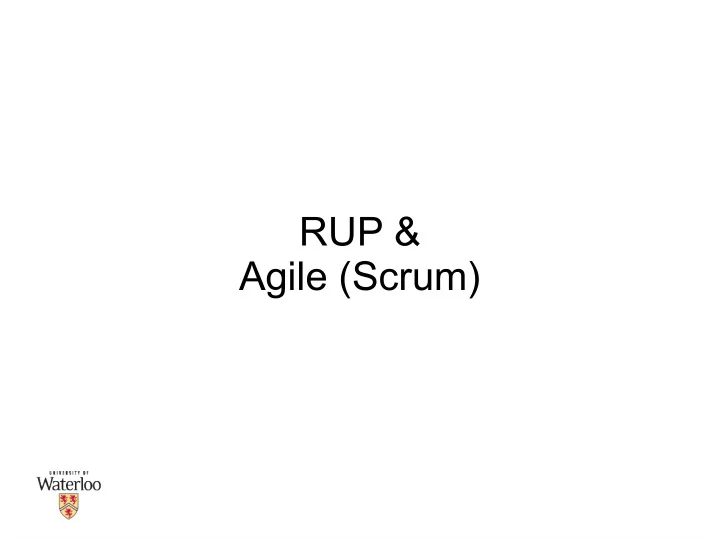

RUP & Agile (Scrum)
Waterfall Traditional way to build systems Sequential ● detailed planning – problem is identified, documented, designed – implementation tasks are identified, scoped and scheduled – approvals & revisions ● development cycle ● testing cycle ● bug fixing cycle
Waterfall Strengths ● logical – requires preparation before execution ● organized – documented, – planned – deviations are exceptions and are tracked
Waterfall Weakness ● not very flexible – good ideas need to be identified upfront – but what if I get an idea midway through development? – “a great idea late in the release cycle is not a gift, it’s a threat” ● documentation heavy need to protect data – abstract use encryption for storage
RUP Process ● configurable – no single process is suitable for all software development. – adapts to small & large development teams ● documentation – model based artifacts – UML
RUP Building blocks ● roles (who) – responsibilities ● tasks (how) – unit of work – result oriented – should be useful ● work products (what) – resultant product
RUP Life-cycle Phases ● four phases – inception, elaboration, construction, transition ● characteristics – sequential in nature ● hmm... sounds like waterfall methodology – each phase focuses on a ● key objective ● milestone delivery
RUP – Life-cycle Phases Inception Construction ● vision document ● build the software ● can be broken down into – scope the system iterations – identify major players – risk, cost etc Transition Elaboration ● transition from ● risk identification development to production ● problem domain ● analysis & architecture
RUP Engineering Disciplines Business modelling Implementation ● domain understanding ● develop components Requirements Test ● vision document & use ● testing throughout the cases project Analysis & Design Deployment ● blueprint for system ● product releases realization ● software delivery
RUP
RUP Best Practises Develop iteratively ● not possible to – define the problem upfront – design the entire solution ● each iteration ends with a release Manage requirements ● use case to capture functional requirements ● should be traceable
RUP Best Practises Use components Model visually ● different models to communicate – different aspects – with different stakeholders – UML
RUP Best Practises Verify quality ● review – functional requirements – non-functional requirements ● should be part of the process Control changes ● continuous integration
Scrum Principles ● building working software that people can get their hands on quickly ● cross functional teams empowered to make decisions ● rapid iteration with continuous customer input
Scrum in a Nutshell Framework ● iterative & incremental Sprint ● development done in sprints (cycles) ● sprints are time-boxed – end after one month no matter what ● deliverables are static for each sprint ● progress reviewed at the end of each sprint ● goal: deliver working product
Inspect & Adapt Intent ● “development inevitably involves learning, innovation and surprises” Recipe ● take a short step ● inspect result & practise ● adapt if required ● repeat forever
Meet the Players Product Owner ● objective is to maximize ROI – has profit & loss responsibility ● identify product features (product backlog) ● define feature prioritization – satisfy key stakeholders – alignment with other strategic objectives – risk identification ● actively interact with the team
Meet the Players The Team (pigs) ● builds the product ● cross functional – analysis, development, testing, interface design, documentation, database design etc.. ● self organizing ● small in size (roughly seven) ● can be feature specific
Meet the Players Scrum Master (Mr. Scrum) ● acts as a Scrum educator and a facilitator – does whatever in his power to help the team and product owner be successful ● should not be same as the product owner – conflict of interest
Scrum in Action Define sprint ● identify the items from “ release backlog” ● assign weight to each item – product owner – based on value – team – based on effort ● lock commitment
Scrum in Action Daily scrum ● 15 mins every day ● Monitor progress by answering – What have you done since yesterday? – What are you planning to do by today? – Do you have any problems preventing you from accomplishing your goal?
Scrum in Action Monitoring progress ● burndown chart – reach zero effort by the last day of sprint http://www.xqual.com/resources/images/scrum_burndown_chart.gif
Scrum in Action www.methodsandtools.com/archive/archive.php?id=18
Scrum in Action Sprint Review Meeting ● review the work that was – completed – not completed ● Inspect & adapt
RUP or Agile Similarities ● iterative ● division of work ● continuous testing
RUP or Agile Differences ● Management style ● RUP is predictive, agile is adaptive ● customer interaction ● agile requires a seasoned team ● knowledge sharing
Recommend
More recommend